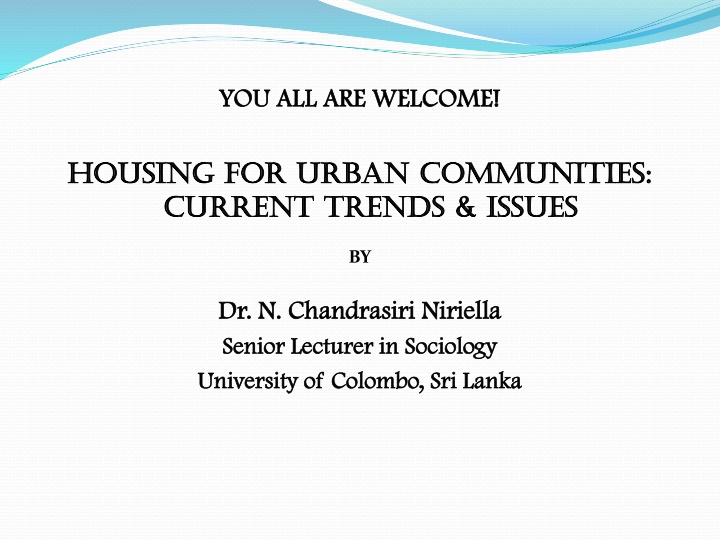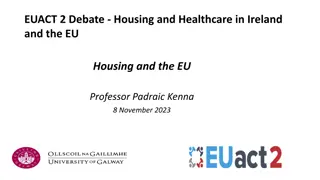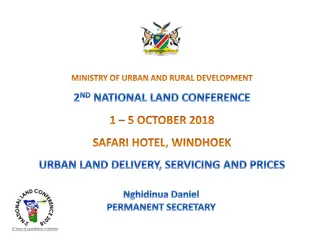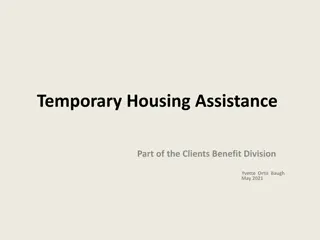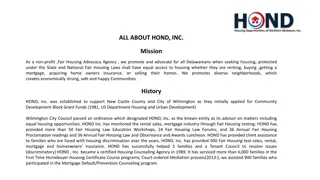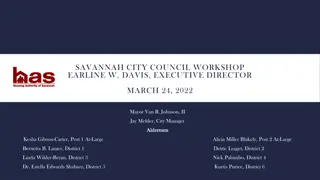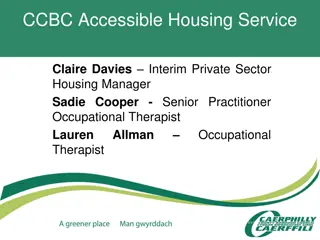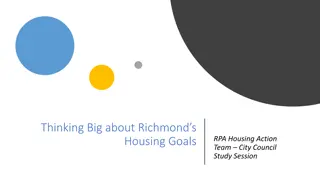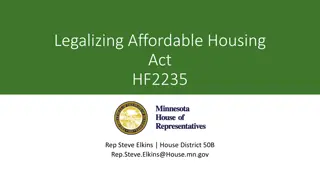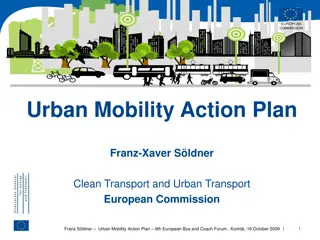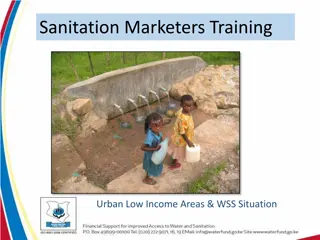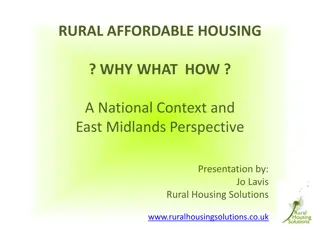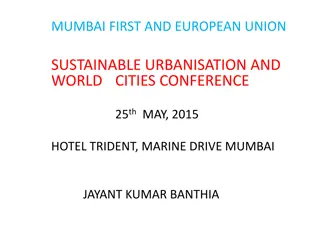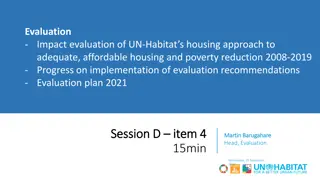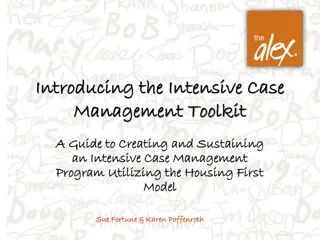Housing Challenges and Solutions in Urban Communities
Shelter and housing play vital roles in social development, affecting access to resources. Sri Lanka faces urban housing issues with a focus on underserved areas in Colombo. Solutions like large-scale housing complexes have been critiqued for lacking in meeting qualitative needs. This study aims to analyze the relationship between state, market, and social classes in urban housing policies in Sri Lanka.
Download Presentation

Please find below an Image/Link to download the presentation.
The content on the website is provided AS IS for your information and personal use only. It may not be sold, licensed, or shared on other websites without obtaining consent from the author.If you encounter any issues during the download, it is possible that the publisher has removed the file from their server.
You are allowed to download the files provided on this website for personal or commercial use, subject to the condition that they are used lawfully. All files are the property of their respective owners.
The content on the website is provided AS IS for your information and personal use only. It may not be sold, licensed, or shared on other websites without obtaining consent from the author.
E N D
Presentation Transcript
YOU ALL ARE WELCOME! YOU ALL ARE WELCOME! HOUSING FOR URBAN Communities: HOUSING FOR URBAN Communities: CURRENT TRENDS & ISSUES CURRENT TRENDS & ISSUES BY Dr. N. Dr. N. Chandrasiri Chandrasiri Niriella Niriella Senior Lecturer in Sociology Senior Lecturer in Sociology University of Colombo, Sri Lanka University of Colombo, Sri Lanka
Shelter is a fundamental human need. Housing is one of the most importance aspects of social development. It is not just a matter of shelter and space. But also affects access to other materials and social resources.
Urban Housing Question in Sri Lanka Sri Lanka is having an acute urban housing problem. Therefore, a sound national housing policy for Sri Lanka should necessarily address both the following aspects: The UDA (2011) has been estimated that there are around 68,812 households in Colombo are located in 1,499 underserved areas, constituting almost half the city s population (51%), and, Production of good houses for the urban poor and emerging middle class groups in the Colombo Metropolitan Region (Niriella, 2010).
The Problem The present day version of shelter in the form of mass housing are usually answers to the quantitative requirements of people such as income level, family size, floor area, design standards, cost, profit or surplus factors, etc. Housing could also facilitate the realization of other human needs which are of a qualitative nature. The qualitative requirements are the socio-cultural and psychological requirements (e.g. neighborhood relationships, environmental qualities, identity, privacy, security, social status, etc.).
The solutions for the housing problems in Sri Lanka in the form of large scale public sector housing complexes and condominiums are considered by some critics as failures in this context. It is argued that the lack of self-expression in prototype as well as high-rise houses of those housing units is unattractive to potential buyers or inhabitants. This has led to a situation where people are forced to buy or settle what is supplied by the existing housing market. Sri Lankan politicians, policy makers, & city planners often pay for more attention to housing production than the social issues & human needs.
Main Objective and Research Question The main research objective of this study is to understand the relationship between state, market and social classes in Colombo in relation to the existing urban housing policy and its implementations in Sri Lanka. The main research question addressed in this study is to investigate the impact of the neo-liberalization policy on existing urban housing policy in Sri Lanka.
Methodology It has focused on three selected major urban housing complexes in the Colombo Metropolitan Region. They are: Sahaspura - A Relocated Low-Income Housing Complex (Condominium) constructed by the government in the 1990s (2001). Mattegoda - A Lower Middle & Middle Class Housing Complex constructed by the government in the 1980s (1985) and, Millennium City - A Middle Class & Higher Middle Class Housing Complex constructed by the private sector in the 1990s (2000). The choice was mainly based on all the income categories of the residents/actual inmates (e.g. lower income; lower- middle& middle income; and middle & higher-middle income).
The Sample The Sample The sample for the quantitative survey was selected by using the random sampling method. The sample size was kept at 325 units (respondents-heads of the households) from the three- selected housing communities (100, 112 & 113 =325 respectively).
The following main research tools were employed for the data collection among the respondents of the selected housing complexes: 1. Sample Survey 2. In-depth interviews, and, 3. Non-Participant observation Both quantitative and qualitative data, for this study were collected within 2006-2010.
Classes in the Selected Three Communities According to the overall picture and the analysis of the data on education, income and occupation, the three main determinants of Socio-Economic Index (SEI), leads the researcher to conclude that the majority of residents of Sahaspura Community belong to the lower class. The residents of the Mattegoda and Millennium City communities belong to the middle classes. However, residents of the Millennium City community can be rated with higher socio-economic status community (e.g. the index value is 1.351 for the Millennium City when compared to Sahaspura and Mattegoda locations whose value is 0.409 and 0.720, respectively). than the Mattegoda
Neo-Liberalization Policy in Sri Lanka from 1977 The neo-liberalization policy brought about major changes in and around urban areas of Sri Lanka. They are: Granting of tax concession other relief to the private sector Setting up of various business ventures in urban areas (e.g. local & foreign) The setting up of Free Trade Zones and Industrial Zones (e.g. suburban areas like: Katunayake, Biyagama, Ratmalana, & Piliyandala, etc.) Privatization of government establishments The establishment of a private transport system, private banks, postal and telecommunication, hospitals, international schools & campuses, roads and building work, tourism, and media in the early 1980s (which have contributed to the expansion of employments as well as various opportunities for the people, especially in the urban areas) Sri Lankans were allowed to work in the Middle-Eastern & other countries
Neo-Liberalization Policy, Trends & Issues Labor economy was replaced by a service economy Various job-opportunities were started to grow within urban space The people who emerged as new-capitalists paid their special attention towards migration to the city of Colombo, and, As a result, the government to provide housing facilities for the population who recently migrated to the city of Colombo.
For example, in the district of Colombo For example, in the district of Colombo (following percentages were increased (following percentages were increased during1986 during1986- -2001/Census Reports) 2001/Census Reports) the employed population is occupied in non- agricultural work (nearly 95 percent) professionals and technicians (from 9.1 to 19.0 percent) administrative and managerial (from 2.5 to 3.8 percent) private business owners (6.0 percent), and, production, transport, labor population (from 43.4 to 45.7 percent)
Trends & Issues The growth of professional & managerial forces and unskilled-workers in the Colombo district has led to rising high demand for urban land and housing. The changes in the labor market towards a professionalized workforce influenced the rising of price of land and houses in the given area. There were strong links between changes in occupational and income structure, and changes in the position of different groups within the housing market in the Colombo Metropolitan Region, and, Growing social and spatial polarization within the housing market with the growth of a luxury housing market for the wealthy at the top and a residual housing market at the bottom for the economically and socially marginalized poor.
Housing Policy/Programs Periods (1948-2010) In Sri Lanka, the private sector to a certain extent contributed to urban housing supplies during the decades between 1940 and 1960(Rent Control Act of 1941, Housing Loan Act of 1949, Department of National Housing in 1953, the Commissioner of National Housing). However, beneficiaries were mostly the urban middle class people. 1. 2. During the period 1970-76, because of the closed economic policy that has been followed as an economic strategy these social actors did not come forward and because of the government policies they did not take any initiative to provide houses (the Rent Act of 1972 and Ceiling on Housing Property Law of 1973).
The government that came into power in 1977 was very keen in supplying houses for urban population though it was a problem for the government to supply houses single handedly in the face of the new demand for the same. The Year - 1987 be declared as an International Year of Shelter for the Homeless . In this process, the Hundred Thousand Houses Program (HTHP-1978- 1983), the Million Housing Program (MHP-1984-1989) was implemented in Sri Lanka. Later, the project was extended to the 1.5 Million Housing Program (1.5MHP-1989-1994). 3. Public and private sectors urban housing programs between 1995 and 2004. The main thrust of the housing development strategy was to promote self-help initiatives and mobilize the potential of private developers . Post-2004 onwards, eliminates slums and shanties from the city (core area) of Colombo by relocating dwellers in modern houses. Liberated lands are to be utilized for commercial and mixed development purposes. The estimated budget is Rs: 2.5 million per unit to construct 66,000 high-rise housing units in Colombo to relocate the residents of under-served settlements in the city (2010). 4. 5.
Urban Policy Related Slogans of the Concerned Authorities Housing, in our thinking, does not mean only a roof over the head. It also means the contentment of the heart (1980s) Our main objective is provision of homes for the people and land for the development (1990s/2000) The government was committed to giving a human face to the market economy (1990s/2000) We have to develop this city; we have a plan to create it as a sustainable city (1990s/2000) Colombo poor get modern housing (1990s/2000) Slum people are drugs addicts, they are useless: we have to chase them out of the city (1990s/2000) There is no land in the city, we need whatever remaining land for business premises and condominium, and so, housing complexes have to be established in the outer areas of the city (2000) We are always willing to provide housing loans to the richest customers who are planning to build their houses in urban areas (2000), and, Every family in Sri Lanka should own a house (2005-2010)
Financial Institutions and their Commitments on Urban Housing During 1980-1990 credited to the Sevana Fund , Rs: 400-500 Million per annum for the poor SMIB grants housing loans about 12,000-13,000 per annum Rs: 10 billion for middle class groups HDFC grants loans about 9,000 loans per annum Rs: 10 billion for middle class groups Thus, NHDA focuses most of its funds not on low-income groups, but on middle income groups. Lending practices of Banks view the poor as a high risk category (Ministry of Housing and Common Amenities 2009) Major commercial banks had granted 97,983 housing loans to the value of SLRs: 34,227 million during 2006 (Central Bank). Most of the private banks have concentrated on the urban middle class customers and, therefore, have located most of their branches in the urban areas.
Private Developers and Builders in the CMR The boom in the property market, during the period 1978-84, resulted in the creation of a new generation of property developers who concentrated on housing development in contrast to land development. As result, a number of building construction organizations (2265) were established over all nine provinces in the country in 2006. Most of them (about 35 percent of developers/builders - 800) have been scattered in the Colombo Metropolitan Region ICTAD). . For example, about77 condominium projects were established in the city of Colombo during 2002-2004 (CMC). Most private contractors concentrate on high-end condominiums or land sub- division, and sale with basic services. These are primarily for upper or upper middle income groups, and the middle or low-income groups are left in the lurch. David Harvey (2006) stated that Neo-liberalization has been spectacularly successful from the standpoint of the upper classes but not for generating growth Thus, our argument is that those who gain benefits mostly in this current housing market process in the city of Colombo are the people who belong to the middle and the upper middle classes.
Complains from the Complains from the Sahaspura (Trends & Issues) (Trends & Issues) Sahaspura Community Community It is important to consider some of the grievances and disadvantages associated with resettlement in new apartments: Now, daily we are going out and coming back to the house by lifts, but sometimes these lifts are not properly working, most of the times over-crowded, so we have to wait for some time, otherwise we have to go up and down by walking. I am old now, I am suffering from Asthma (Palaniuppan, 55 years of age, Sahaspura Community).
In the earlier place (Watta-Slum area), I had a small garage for bicycle repairing, but here is no any place (space) for such kind of work. Even, we are living in the 7th floor of the building, so, our authorities must give a solution for this kind of matter too (Peter, 49 years of age, Sahaspura Community). Recently, in the city of Colombo public housing has been built as high-rise structures(e.g. Sahaspura, Mihindu-Senpura, Sirisara-Uyana, Methsara Uyana, Sirisadha Sevana, Randiya Uyana, Sauru Pura, Laksandha Sevana, Muwadora Sevana, etc.). Sirimuthu Uyana,
Other Complains from the Sahaspura Community (Trends & Issues) Poor maintenance, the regular breakdown of elevators, lack of open spaces and landscaping, lack of common places, isolation, and continuous noisy behavior among the residents in the housing community, etc. (The city planners might be tending to propose isolated areas for low-income housing that considering the land value, and high demand for the luxury markets in the core areas of Colombo. Sociologists were warning of the dangers of isolating the poor in dehumanizing structures).
Private luxury high-rise apartments have their own system to regular maintenance their buildings but low-income high-rise housing does not have such a proper mechanism to maintenance their building due to lack of sufficient money (Low-income house owners believe it is the responsibility of the government or local authorities and blame them for the situation). The high-rise low-income housing is new for Sri Lanka. However, past experiences come from other countries would be very useful for Sri Lankan high-rise housing.
For example, by the mid-and late 1960, the British government stopped subsidizing flats over six stories high, and a consensus emerged that high-rise housing did not suit families with young children. In Britain in particular, it has been found that social housing could be built at medium densities in which at least half of all families could have direct access to outside ground-level space (Foley, 1980). High-rise housing for low-income people is not a universally accepted solution for housing for low- income people and some countries have totally rejected high-rise for low-income housing due to significant failures in the past (Foley, 1980).
One special feature is that, for the first time, the full- ownership of these houses has been granted to the residents. It is a new trend that a considerable number of people have sold their houses to others and bought residence in such sprawling land areas as at the Kadawatha, Homagama, Hokandara, Meepe, and Padukka in urban fringe. In a few cases the housing units in the Sahaspura Housing Community, previously occupied by the working class people, have been bought by some people belonging to the middle class.
Mattegoda Housing Community (Trends & Issues A) The Mattegoda Housing Complex is located in a rural environment of the suburban Kottawa. From the inception of this housing complex in 1985, the people who came to reside were from the lower middle class and the middle class. It was one of the decisions of the then government to establish complex to provide shelter for the people who were employed the state and private sectors. this housing
With the establishment of the housing complex, the infrastructure facilities (e.g. roads, electricity, communication facilities, transportation and bus services, supermarkets, community centres, and pre-schools, etc.), began to improve in this area. pipe-borne water, These new facilities in the area of the Mattegoda Housing Complex and the nearby areas caused mobility of the middle class people to live there, resulting in a high increase of land value.
Mattegoda Housing Community (Trends & Issues B) Under the housing development program, several similar housing complexes such as, Rukmalgama (1980), Raddolugama (1982), Madumagewaate (1982), Jayawadenaegama (1984), Ranpokunagama Mattegoda (1985), for the lower middle income and the middle income people were established in several suburban areas in Colombo. As a result of these housing programs, a new sub- urban area emerged in a circular fashion beyond the Colombo city. (1984), and
Establishing housing complexes in the suburbs is to dissolve the crowed that comes in to the capital Colombo city. But it is not a successful policy, because even though they are settled in the suburbs, they are compelled to come into the city for employment. Therefore, the traffic problems have been increased in the city and its suburbs. substantially
Millennium City Housing Community (Trends & Issues) The government also provided opportunities to, a certain extent to construct private housing complexes for the middle class and higher middle class people. Under such opportunities, the first time the Millennium City Housing Complex was constructed for the middle class and higher middle class people.
This caused an influx of the middle class people from different places of the country into urban fringe area where the people of the working class once lived. Consequently, a tremendous increase of the land value, mainly due to the improved infrastructure facilities, could be observed in the Millennium City Housing Community area. The concomitant effect discernible in this trend is that there is a keen competition among the property developers to cater to the housing needs of the middle class and the higher middle class groups.
Since a large number of private housing complexes have already been built adjacent to the suburban areas, a congestion of middle class people into these areas too is seen. Due to neo-liberalization of the economy, people are able to do changes/fashions their houses as per the modern housing styles in the housing community. It can be said that a new kind of middle class culture is now emerging in these zones of the new housing communities.
Conclusions Conclusions Since the introduction of neo-liberalization policy in the country, the existing housing market in the city of Colombo is becoming much more complex. In recent years, the market has exhibited some significant changes. Both the state and the private sector are taking part in the housing market in Colombo while the private sector has taken its leading role today. The state plays a dominant role in the housing market. However, the housing problem cannot be addressed without first recognizing that its causes and proposed solutions are the by- products of deeply rooted inequalities of class.
The housing policy should not change according to the change of government or minister . The City s development activities should be looked at mainly from the perspective of people shygiene and providing housing as an area of creating a better living environment for residents . City or town planning should concern over providing good houses with infrastructure facilities, specially the transport facilities that would well connect to the people s residence to their work places. The overall objective of creating a new city or town plan should be to provide a better environment for residence, business and recreation.
THANK YOU VERY MUCH THANK YOU VERY MUCH HAVE A NICE DAY! HAVE A NICE DAY!
